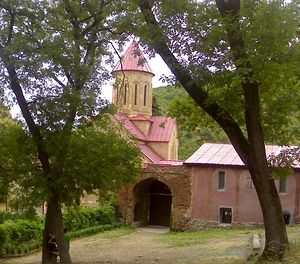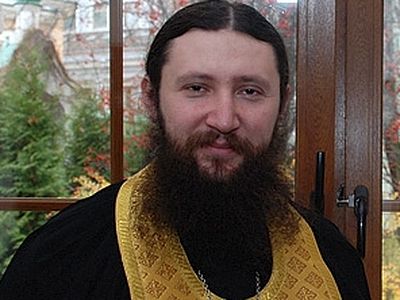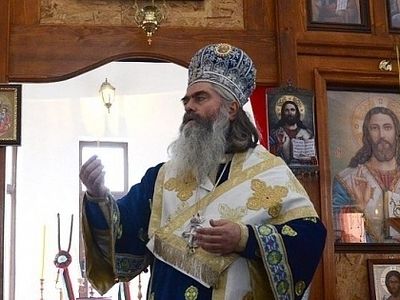The Betania Monastery of the Nativity of the Mother of is a medieval Georgian Orthodox monastery in eastern Georgia, located 16 kilometers (10 miles) southwest of Tbilisi, the nation’s capital. It was built during the "Golden Age" of the Kingdom of Georgia, in the late twelfth, early thirteenth centuries, and is notable for its wall paintings, which include a group portrait of the Georgian monarchs of that age.[i]
* * *
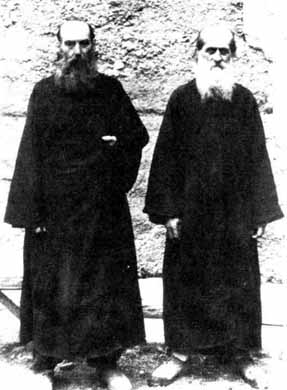 Betania elders: Archimandrite John (Maisuradze) and Archimandrite George (Mkheidze) in schema, John.
Betania elders: Archimandrite John (Maisuradze) and Archimandrite George (Mkheidze) in schema, John.
Betania Monastery was not officially considered active—it was simply recognized as a "distinguished architectural monument"; the monks were considered its guards, and were even paid for that job. But in fact, it was like an active monastery: lampadas burned before the icons in the church, candles were lit, divine services were conducted, and the fathers wore monastic garb. The faithful came here on feast days, there were cross processions, baptisms and marriage ceremonies were performed; however, under persecution and lacking other clergy, Fathers John and George were not able to perform the wedding sacrament for all who asked.
No small number of people came during those years to the loving elders, and these ascetics' spiritual characteristic s have been preserved for us thanks to the memory of these guests. We cite, for example, the recollections of M. L. Mikhailova, who was a frequent guest of the Betania monks.
"My mother was Georgian, and a believer. In the years 1941–1948, we lived in Orbeti, and often went to Betania Monastery. I became acquainted with Fathers John and George in 1941–1942. They were amazingly kind, attentive, and sensitive.
"Fr. George was thin, and wore glasses. He was often ill, and therefore spent less time with us. Fr. John, however, was full of life, cheerful and affectionate. I still feel the warmth that he sowed in my childhood heart. After services, Fr. George went to his room for a rest, while Fr. John remained to talk with us. We children were so spoiled by him that one day, on the feast of St. John the Baptist, we covered him with water from head to toe. There is a tradition amongst the faithful to pour water over ourselves on that day. Our parents began to scold us for such familiarity, but Fr. John assuaged them, saying that today is a feast, and that is just what should be done. Fr. John and Fr. George taught us the rules of behavior in church, how to confess and receive Communion; they always asked us whether we had stolen anything, gossiped, hurt anyone, and so on.
"If Russians came to the monastery, the fathers would do the services mainly in Church Slavonic.
"I remember when Fr. John went to the hospital for surgery, Fr. George was worried, and even wrote a letter to the head doctor with a burning request that he do everything possible to make Fr. John recover. Fr. John, in his turn, was worried about Fr. George remaining alone in the monastery. The two fathers were very attached to each other, and loved each other with a true, tender Christian love.
"Despite this brotherly closeness, their personalities were very different, while their souls were equally pure and bright. They taught us children to always repeat the short prayer, 'Lord, have mercy.' They said that this would keep us in continual communion with the Lord, and will help us to live a righteous life."
The Holy Synod of the Georgian Orthodox Church, at a session on August 18, 2003, canonized the holy confessors Archimandrite John (Maisuradze) and Archimandrite George-John (Mkheidze). They are commemorated on September 8/21.
We have decided to acquaint Russian [and English] speakers with the lives of these newly-canonized Georgian saints.
Holy Confessor John (Maisuradze; †1957)
Archimandrite John (in the world, Vasily Maisuradze) was born in Tsinkvali in 1882. From his childhood, he labored in the church. At age twelve, he selflessly helped the abbot of Betania Monastery, Hieromonk Spyridon (Ketiladze), who had restored the monastery with great effort in 1894–1896.
In 1903, Vasily arrived at the Holy Mountain of Athos, where he received the monastic tonsure with the name John, and labored in the skete of the Apostle John the Theologian. Soon Monk John was ordained a deacon, and then a priest. He lived seventeen years on Mt. Athos. Hard times came, and he was forced along with other Georgian monks to leave the Holy Mountain in the 1920's.
After returning to his homeland, Fr. John settled in the monastery of St. Armaz, where he lived with only one other monk, since by that time the godless communists had begun their persecutions. One day, armed Chekists came to the monastery, forced both of the monks to the nearest ditch, and shot them in the back. The monks fell into the ditch and the chekists considered them dead, but by God's mercy, they both survived.
When Fr. John recovered, he came to Betania Monastery, where his childhood instructor, Hieromonk Spyridon (Ketiladze), was still living. In 1924, Fr. George (Mkheidze) came to Betania, and these two holy fathers remained in the monastery for the rest of their lives. Fr. John was accustomed to labor from childhood, and was able to establish the monastery's household and agriculture magnificently. The fathers greeted every person who came to the monastery like a dearest and closest friend, sent to them by the Lord Himself. They surrounded him with the most touching love and attention.
Fr. John loved children very much and spoiled them; he always had sweets ready for them. Children also felt very free with him. One day, Fr. John received the seminarian of the Moscow Theological Academy, Iraklii Shioloshvili, with amazing honor. This action of Fr. John's make one think that he saw in that young man the future Catholicos-Patriarch [Ilia] of all Georgia.
Fr. John lived a very strict life. He fasted very much, worked all day, slept on bare boards, and prayed all night. Those who lived near him were perplexed, and did not know if the holy father ever rested, or where he got so much energy and vigor.
Fr. John himself did the most difficult work in the monastery; he was very worried about Fr. George, who had weak health. Nevertheless, St. John went to the Lord first. After a brief illness, he reposed in the Lord in 1975, at age seventy-five. He is buried in the court of Betania Monastery.
Holy Confessor George-John (Mkheidze; †1960)
Archimandrite George (Mkheidze) was born in the year 1887, in the village of Skhvavi, Ambrolauro region (Racha, Georgia). His father, Methodios Mkheidze, was a respected man, possessed military awards, including the cross of St. George, which he recieved for taking captive the famous Imam Shamil. George had seven brothers and three sisters. After receiving his primary education in his village school, the youth was sent to Tbilisi, where with the support of his uncle he continued his studies, serving for a time as personal secretary to righteous Ilia Chavchavadze.
Later George went to St. Petersburg to enter military academy, but he soon had to return to his native village. At that time, he witnessed the spiritual transformation of his older brother, Polycarp, who had decided to dedicate himself to God. Polycarp went into solitude and began to pray ceaselessly. George's brother soon died, having first warned his family that he was "going to the Most Pure Mother of God," whom he had been vouchsafed to behold even during his life.
The year Polycarp died (1909), his notes came into George's hands. These notes established the latter's life path. George announced to his family, "It's decided—I am going to sacrifice myself to the Lord; it's my path."
The young man labored for a time in asceticism in a cave not far from his village, then departed for Samegrelo, and became the student of St. Alexiy (Shushanin). He was tonsured into monasticism by the holy hieromartyr Nazarius (Lezhava). The modest and educated monk was soon ordained into the priestly rank, and later became an archimandrite.
After the Bolshevik revolution, St. George would endure no little persecution, and he suffered for his faith. One day, in 1924, when he was serving in the Khirss Monastery, chekists attacked Fr. George, beat him badly, cut his hair and half his beard, threatening to kill him. He wore a bandage on his face after this until his beard grew back.
Two of his brothers were poisoned by the atheistic worldview—Ivan and Peter—and rose up against him. They mocked him in every way. For example, they once cut his beard as he slept, and another time, they lured him into a room where a prostitute was waiting for him, then slammed the door shut and locked it from the outside. Soon, however, the woman began to shout with irritation to be let out, "away from this madman." When the brothers opened the door, they saw George on his knees, facing the wall, and praying fervently. Peter Mkheidze worked in the cheka, and with time, climbed high on the career ladder—he became Beria's assistant. He even changed his patronymic, ashamed that his brother was a monk. Later, in 1938, both communist brothers perished: Peter was shot together with his wife, and Ivan committed suicide.
In 1924, Fr. George came to Betania Monastery, where he was met by Fr. John (Maisuradze). From then on, these two holy fathers lived in oneness of soul, serving God in that monastery.
During World War II, when famine was all around, Sts. John and George produced their own bread, cheese, and honey, and they fed everyone who came to them, giving them food to take home, even giving them money. At that time, Betania Monastery was visited by both the faithful and the idly curious. Although these visitors disrupted the monastery's peace, the holy fathers met each person with great love and attention, and when the visitors left, they took with them the warmest feelings toward this place and for these remarkable men.
Tall, thin, and stately, Fr. George appeared much more austere than Fr. John, talked less with visitors, and did not give treats to the children. Nevertheless, he had a loving heart, and generously distributed the fruits of his monastery labors to the needy visitors. "God will give unto us, God will not abandon us," he often repeated.
Fr. George was adorned with the gift of clairvoyance and healing, which gifts he scrupulously hid. But when they became known, he strove to explain them away with everyday causes. Once he called an entirely unknown visitor by name, and when he noticed the latter's amazement, he said that he supposedly had been at his baptism, which had occurred thirty years earlier. When the saint's nephew brought a sister he had not seen for forty-eight years to him without notifying him first, he saw that Fr. George had already prepared everything for the reunion ahead of time. Many cases of healing by Fr. George's prayers are well known. A Russian elder of that time, Schema-Abbot Kuksha, also spoke very highly of the two fathers.
In 1957, when Fr. John reposed in the Lord, Fr. George was tonsured into the great schema with the name John—just as his spiritual brother was named. He remained as the last monk in the only active monastery in Georgia at the time. All the monastery cares fell onto the shoulders of Fr. George-John, which broke his already feeble health even more.
Several days before his repose, Fr. George-John was in the city, where an angel appeared to him and told him of his approaching end, commanding him to wait for it in the monastery. That is how it happened. St. George-John (Mkheidze) departed to the Lord in 1960, and was buried in the court of Betania Monastery, next to St. John( Maisuradze).
* * *
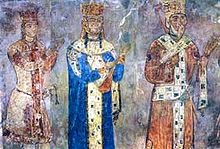 The royal panel at the Betania monastery: George IV Lasha, Tamar, and George III (from left to right).
The royal panel at the Betania monastery: George IV Lasha, Tamar, and George III (from left to right).
